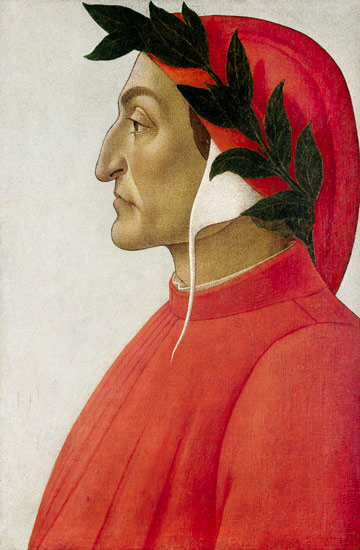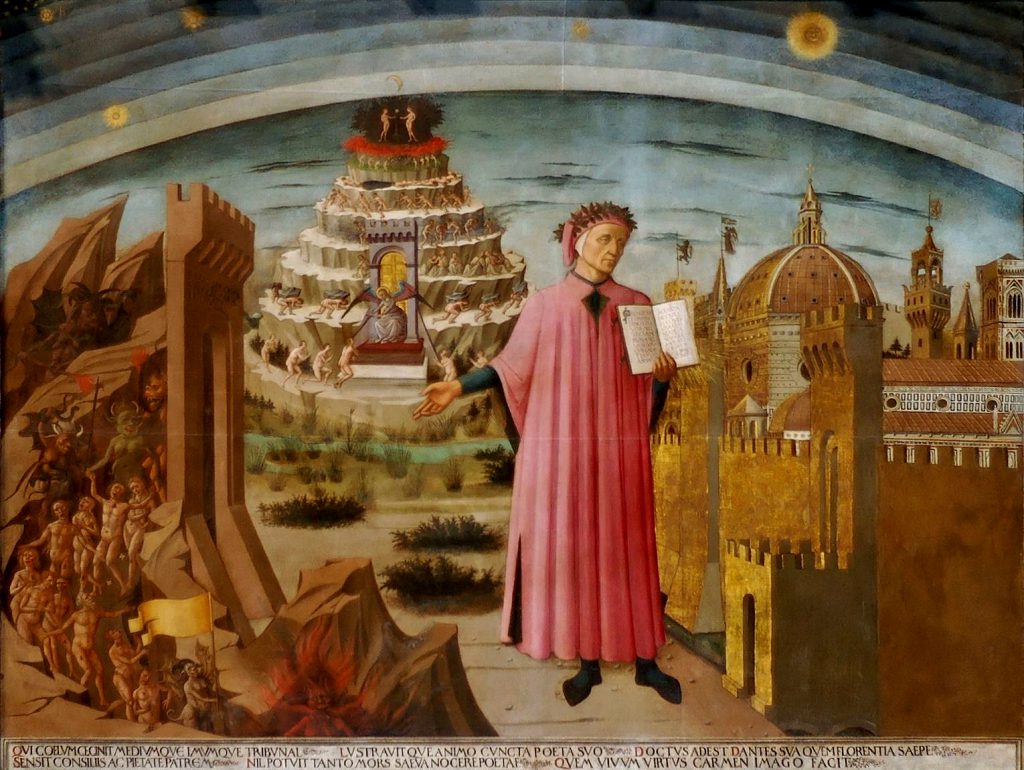
Dante Alighieri (1265-1321)
In the night from September 13 to 14, 1321, major Italian poet Dante Alighieri passed away. His Divine Comedy is widely considered the greatest literary work composed in the Italian language and a masterpiece of world literature. Together with his poet colleagues Petrarch [7] and Boccaccio,[8] Dante – the ‘supreme poet’ (il Sommo Poeta) – is referred to as “the three crowns” or “the three fountains”. Moreover, he is also called the “Father of the Italian language”.
Why You Should Read Dante
You haven’t read Dante yet? Then you should definitely do it right now. Maybe you are scared of a work entirely written verses, a work originating from a time far, far away that seems to have no connection to our world today. But that’s not true – well, of course it is written in verses. But, large parts of the entire cosmos of our western literature as well as our culture have been heavily influenced by the Italian poet’s ‘La Divina Commedia‘. Have you heard of best seller author Dan Brown‘s latest work ‘Inferno’? The whole plot of the thriller is nothing but a praisal for Dante’s work, when protagonist Robert Langdon walks in the footsteps of Dante through today’s Florence trying to save the world (again).
“All hope abandon, ye who enter in!” (Dante Alighieri, from ‘Inferno’, Canto III, inscription written over the Gates of Hell)
Dante’s Date of Birth
Dante was born in Florence, Italy; the Casa di Dante, now visited by tourists, was built on the approximate site of his actual birthplace, but has nothing in common with it. The exact date of birth is unknown, although it is generally believed to be around 1265. This can be deduced from autobiographic allusions in La Divina Commedia. Its first section, the Inferno, begins “Nel mezzo del cammin di nostra vita” (“Halfway through the journey of our life“), implying that Dante was around 35 years old, since the average lifespan according to the Bible is 70 years; and since his imaginary travel to the nether world took place in 1300, he must have been born around 1265. Furthermore, Dante claimed that his family descended from the ancient Romans. Dante’s family had loyalties to the Guelphs, a political alliance that supported the Papacy and which was involved in complex opposition to the Ghibellines, who were backed by the Holy Roman Emperor.
“At that very moment, and I speak the truth, the vital spirit, the one that dwells in the most secret chamber of the heart, began to tremble so violently that even the most minute veins of my body were strangely affected; and trembling, it spoke these words: Ecce deus fortior me, qui veniens dominabitur michi.”
(Dante Alighieri, from his autobiographical writing ‘Vita Nuova’, The New Life, at the sight of Beatrice)
Beatrice
At age twelve, Dante was promised in marriage to Gemma di Manetto Donati of the powerful Donati family. Such contracting marriages at this early age were quite common at this time, but Dante had already fallen in love with another, Beatrice Portinari, whom he first met when he was only nine and had fallen in love “at first sight”. Later in life, Dante wrote several sonnets to Beatrice, who should become his constant Muse, but never mentioned Gemma in any of his poems. In 1293 Dante published a book called the Vita Nuova (“The New Life“), in which he relates how he fell in love with Beatrice, and found his chief happiness in thinking of her from afar. To take any part in public life one had to enroll in one of the city’s many commercial or artisan guilds, so Dante entered the physicians’ and apothecaries’ guild. This profession was not inappropriate, since at that time books were sold from apothecaries’ shops.
Dante’s Early Years
About Dante’s education not very much is really known, while his interests somehow brought him to discover the Provençal poetry of the troubadours as well as the Latin writers of classical antiquity, including Cicero,[8] Ovid and especially Virgil. His love to Beatrice Portinary was rather unique according to today’s standards. In fact, it was an example of so-called courtly love. Just imagine that he loved her, without ever having spoken with her. Dante’s love for Beatrice (comparable to Petrarch‘s affection for Laura) would be one of his main reasons for poetry and for living. And thus, she also occurs in many of his poems. In 1304 or shortly thereafter Dante published De Vulgari Eloquentia, an argument for writing poems and other works in the language that people speak (in his case, Italian) rather than in Latin.
The Divine Comedy
“Nel mezzo del cammin di nostra vita,
mi ritrovai per una selva oscura,
ché la diritta via era smarrita.”
(When I had journeyed half of our life’s way,
I found myself within a shadowed forest,
for I had lost the path that does not stray.)
– Dante Alighieri, Inferno, Canto I
When he began writing his masterpiece, the Commedia, we do not know. It appears that he had finished the first of its three parts by 1314, and the last only shortly before his death on the night from 14 to 15 September 1321. Let’s take a look on the plot of the Comedy: The poem begins on the night before Good Friday in the year 1300, “halfway along our life’s path” (Nel mezzo del cammin di nostra vita). It begins with Dante lost and walking in a Dark Wood, unable to remember how he got there. Running in panic, he sees a man approaching, and asks for help. The man reveals his identity as the antique poet Virgil. “You cannot get out of the wood by climbing the mountain. You must follow me, and I will take you the long way round“, he offers Dante. “Your Lady Beatrice has sent me to guide you, through the depths of Hell and up the slopes of Purgatory, to meet her in the country of the Blessed.” Virgil then conducts Dante through Hell, a vast funnel-shaped region under the surface of the earth with various kinds of evil deeds punished, down to the center of the earth, where they climb up to the other side at the foot of Mount Purgatory, which is surrounded by cornices on which the seven basic kinds of inclination to sin are purged and corrected. Reaching its summit they find Eden, the earthly Paradise. There Beatrice meets Dante, and conducts him upward through the planetary spheres. Finally, beyond the planets and the stars, Dante beholds the whole company of Heaven assembled together, and is given a vision of the glory of God Himself.

Sandro Botticelli’s Map of Dante’s Hell (1480-1490)
Dante’s Vision of Hell
Allegorically, the Inferno represents the Christian soul seeing sin for what it really is, and the three beasts represent three types of sin: the self-indulgent, the violent, and the malicious. These three types of sin also provide the three main divisions of Dante’s Hell: Upper Hell, outside the city of Dis, for the four sins of indulgence (lust, gluttony, avarice, anger); Circle 7 for the sins of violence; and Circles 8 and 9 for the sins of fraud and treachery. Added to these are two unlike categories that are specifically spiritual: Limbo, in Circle 1, contains the virtuous pagans who were not sinful but were ignorant of Christ, and Circle 6 contains the heretics who contradicted the doctrine and confused the spirit of Christ. The circles number 9, with the addition of Satan completing the structure of 9 + 1 = 10.

Dante shown holding a copy of the Divine Comedy, next to the entrance to Hell, the seven terraces of Mount Purgatory and the city of Florence, with the spheres of Heaven above, in Michelino’s fresco
Writing in Italian
Dante wrote the Comedy in a language he called “Italian”, in some sense an amalgamated literary language mostly based on the regional dialect of Tuscany, but with some elements of Latin and other regional dialects. So why it is called a “Comedy”? In Dante’s time, all serious scholarly works were written in Latin, a tradition that would persist for several hundred years more until the waning years of the Enlightenment, and works written in any other language were assumed to be more trivial in nature. Furthermore, the word “comedy” in the classical sense refers to works which reflect belief in an ordered universe. The Divine Comedy has been a source of inspiration for countless artists for now almost seven centuries. The long list includes of course literature itself, but also music and sculpture as well as cinema and even computer games.
Bill Cook, “Why Every Person in the World Should Read Dante’s Commedia” [10]
References and Further Reading:
- [1] Dante Alighieri at poemhunter
- [2] Dante Alighieri at the Stanford Encyclopedia of Philosophy
- [3] Dante at Online Literature.com
- [4] Dante Alighieri, Poet, Spiritual Writer
- [5] Princeton Dante Project Website that offers the complete text of the Divine Comedy (and Dante’s other works) in Italian and English.
- [6] Danteworlds, multimedia presentation of the Divine Comedy for students by Guy Raffa of the University of Texas
- [7] Petrarch and the Invention of the Renaissance, SciHi Blog
- [8] Boccaccio and his Decameron, SciHi Blog
- [9] Marcus Tullius Cicero – a Homo Novus, SciHi Blog
- [10] Bill Cook, “Why Every Person in the World Should Read Dante’s Commedia”, Stanford University in Italy @ youtube
- [11] Dante Alighieri at Wikidata
- [12] Timeline for Dante Alighieri, via Wikidata






Can you please recommend the best English translation of The Divine Comedy with which to begin?
Thank you,
Toni Ciarlelli